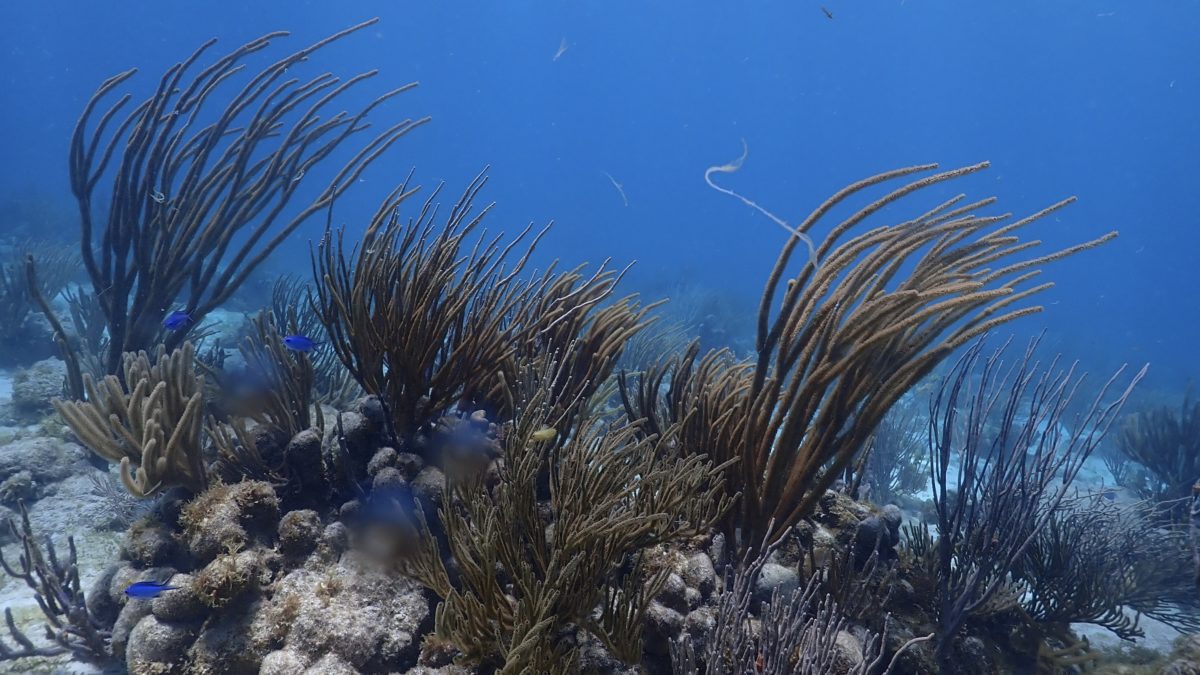WHOI Scientists ‘read’ the messages in chemical clues left by coral reef inhabitants
 A new way to collect compounds from seawater helped researchers identify three metabolites related to coral reefs’ inhabitants and potential disease state. (Photo by Ciara Willis, ©Woods Hole Oceanographic Institution)
A new way to collect compounds from seawater helped researchers identify three metabolites related to coral reefs’ inhabitants and potential disease state. (Photo by Ciara Willis, ©Woods Hole Oceanographic Institution) June 10, 2024
Woods Hole, Mass -- What species live in this coral reef, and are they healthy? Chemical clues emitted by marine organisms might hold that information. But in underwater environments, invisible compounds create a complex “soup” that is hard for scientists to decipher. Now, WHOI coral researchers have demonstrated a way to extract and identify these indicator compounds in seawater, according to study published in ACS’ Journal of Proteome Research
They found metabolites previously undetected on reefs, including three that may represent different reef organisms.
Plants and animals living in coral reefs release various substances, from complex macromolecules to individual amino acids, into the surrounding water. To determine which ones could identify the ecosystems’ inhabitants and be used to measure a coral reef’s health, scientists need to prepare water samples for analysis by concentrating the compounds and separating them from the salty broth. They primarily concentrate and collect these dissolved compounds from seawater on sticky membranes. However, this method misses many important nitrogen-, oxygen- and sulfur-containing compounds produced by marine organisms. These metabolites don’t attach well to the membrane materials and are present at extremely low levels in seawater. To overcome these challenges, Brianna Garcia, Post Doc INvestigator; Amy Apprill, Associate Scientist; Elizabeth Kujawinski, senior scientist, and colleagues at WHOI tested a technique that modified the dissolved metabolites before they were extracted from seawater into a form that’s compatible with membrane materials allowing them to be concentrated and analyzed.
First, the researchers collected and filtered water samples from five coral reefs around the U.S. Virgin Islands. They then used a series of reactions to attach a benzoyl functional group to dissolved amine- and alcohol-containing metabolites. Next, the team extracted the modified metabolites from the samples and assessed their composition and concentrations with liquid chromatography-mass spectrometry. From applying this new technique, the researchers identified 23 metabolites that hadn’t been identified near coral reefs by previous studies, including amino acids, amines, pyrimidine nucleosides and organosulfonic acids, which are involved in photosynthesis and organismal growth. When the researchers analyzed their data, they found that:
- The presence of diseased coral, macroalgae and crustose coralline algae had the greatest influence on the metabolite compositions.
- Some compounds, such as the organosulfonic acid called DHPS, were consistently at high levels in all locations, which suggests the presence of coral and associated organisms.
- Three metabolites (homoserine betaine, tryptophan and γ-aminobutryic acid) had significantly different levels among the five reefs, and the researchers attribute those differences to variations in marine environments and organisms.
The researchers say this study successfully demonstrates how to collect previously overlooked, ecologically relevant compounds in coral reef ecosystems that could be used to monitor them for effects from climate change, natural disturbances and disease activity.
The authors acknowledge funding from the National Science Foundation and the National Oceanic & Atmospheric Administration’s Oceanic and Atmospheric Research Cooperative Institutes.
###
About Woods Hole Oceanographic Institution
The Woods Hole Oceanographic Institution (WHOI) is a private, non-profit organization on Cape Cod, Massachusetts, dedicated to marine research, engineering, and higher education. Established in 1930, its primary mission is to understand the ocean and its interaction with the Earth as a whole, and to communicate an understanding of the ocean’s role in the changing global environment. WHOI’s pioneering discoveries stem from an ideal combination of science and engineering—one that has made it one of the most trusted and technically advanced leaders in basic and applied ocean research and exploration anywhere. WHOI is known for its multidisciplinary approach, superior ship operations, and unparalleled deep-sea robotics capabilities. We play a leading role in ocean observation and operate the most extensive suite of data-gathering platforms in the world. Top scientists, engineers, and students collaborate on more than 800 concurrent projects worldwide—both above and below the waves—pushing the boundaries of knowledge and possibility. For more information, please visit www.whoi.edu.
